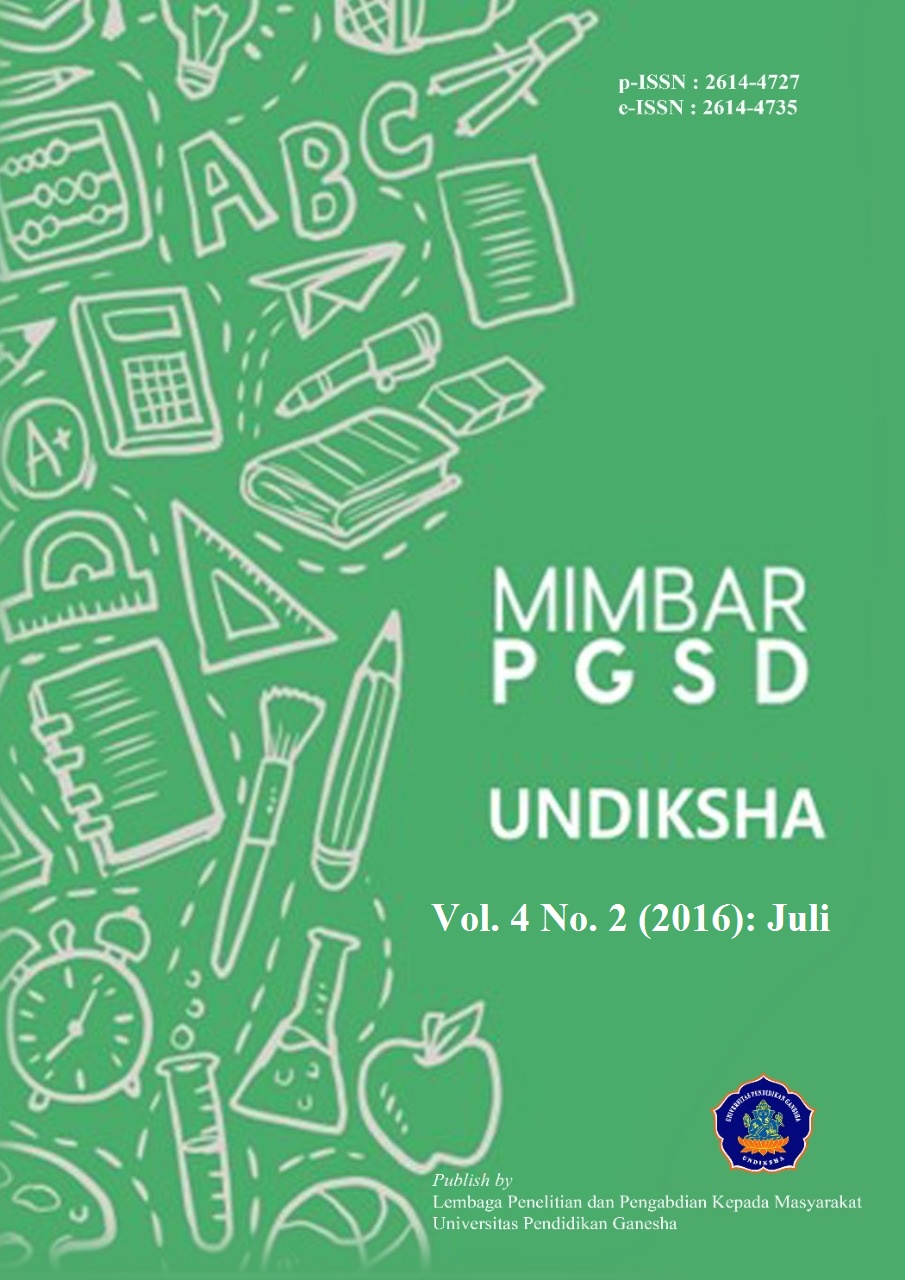PENGARUH MODEL PEMBELAJARAN CHILDREN LEARNING IN SCIENCE (CLIS) TERHADAP PEMAHAMAN KONSEP IPA SISWA KELAS IV SEKOLAH DASAR DI GUGUS VI KECAMATAN BULELENG TAHUN PELAJARAN 2015/2016
DOI:
https://doi.org/10.23887/jjpgsd.v4i2.7710Abstract
Penelitian ini bertujuan untuk mengetahui perbedaan pemahaman konsep IPA antara kelompok siswa yang mengikuti pembelajaran dengan model pembelajaran CLIS dan kelompok siswa yang mengikuti pembelajaran dengan model pembelajaran konvensional pada siswa kelas IV Sekolah Dasar di Gugus VI Kecamatan Buleleng Tahun Pelajaran 2015/2016. Sampel dalam penelitian ini berjumlah 40 orang. Penelitian ini merupakan penelitian eksperimen semu dengan desain post test only control group design. Data pemahaman konsep IPA dikumpulkan dengan menggunakan metode tes pemahaman konsep dengan instrumen tes pilihan ganda. Data dianalisis dengan menggunakan statistik deskriptif dan statistik infransial yaitu uji-t pada tarif signifikasi 5%. Hasil penelitian ini menunjukkan bahwa terdapat perbedaan signifikan pada pemahaman konsep IPA antara kelompok siswa yang mengikuti pembelajaran dengan model pembelajaran Children Learning In Science (CLIS) dengan siswa yang mengikuti pembelajaran dengan model pembelajaran konvensional (thitung = 3,86 > ttabel = 2,021). Dari hasil penelitian, dapat disimpulkan bahwa model pembelajaran CLIS berpengaruh terhadap pemahaman konsep IPA siswa kelas IV SD di Gugus VI Kecamatan Buleleng Tahun pelajaran 2015/2016.Kata Kunci : model CLIS, pemahaman konsep
This study was aimed to determine the understanding differences of the Science’s concept between groups of students who followed the CLIS teaching- learning model and groups of students who followed the learning with conventional learning models at the fourth grade students of elementary schools in Cluster VI Buleleng district in the academic year 2015/2016. The samples of this study were 40 students. This research is a quasi-experimental with post-test only controls group design. The data of science understanding concepts were collected by using the concept comprehension test with multiple-choice test instruments. The data were analyzed by using descriptive and statistical inferential analysis with t-test at 5% significance rates. The results of this study indicated that there are significant differences of science understanding concepts among the group of students who followed the Children Learning In Science (CLIS) learning model with students who followed the learning with conventional learning model (t = 3.86> t table = 2.021). From the results, it can be concluded that the CLIS learning model affected students' understanding of science concepts at fourth grade students of elementary school in Cluster VI Buleleng district in academic year 2015/2016.
keyword : CLIS model, concept understanding
Published
2016-07-21
How to Cite
., K. N. A., ., P. D. N. K. S., & ., D. I. M. T. S. M. (2016). PENGARUH MODEL PEMBELAJARAN CHILDREN LEARNING IN SCIENCE (CLIS) TERHADAP PEMAHAMAN KONSEP IPA SISWA KELAS IV SEKOLAH DASAR DI GUGUS VI KECAMATAN BULELENG TAHUN PELAJARAN 2015/2016. MIMBAR PGSD Undiksha, 4(2). https://doi.org/10.23887/jjpgsd.v4i2.7710
Issue
Section
Articles
License
Authors who publish with the Mimbar PGSD Undiksha agree to the following terms:
- Authors retain copyright and grant the journal the right of first publication with the work simultaneously licensed under a Creative Commons Attribution License (CC BY-SA 4.0) that allows others to share the work with an acknowledgment of the work's authorship and initial publication in this journal.
- Authors are able to enter into separate, additional contractual arrangements for the non-exclusive distribution of the journal's published version of the work (e.g., post it to an institutional repository or publish it in a book), with an acknowledgment of its initial publication in this journal.
- Authors are permitted and encouraged to post their work online (e.g., in institutional repositories or on their website) prior to and during the submission process, as it can lead to productive exchanges, as well as earlier and greater citation of published work. (See The Effect of Open Access)















